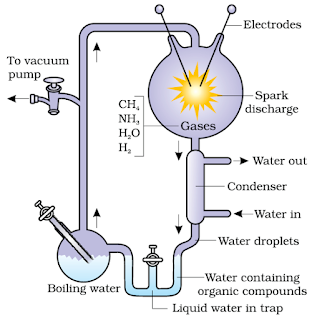Evolution : Notes and Study Materials -pdf
7. EVOLUTION
Evolution is an orderly change from one form to another.
Evolutionary Biology is the study of evolutionary history of life forms.
ORIGIN OF LIFE
– Big Bang Theory states that universe originated about 20 billion years ago by a singular huge explosion.
– The earth was formed about 4.5 billion years ago.
– There was no atmosphere on early earth. Water vapour, CH4, CO2 & NH3 released from molten mass covered the surface.
– The UV rays from the sun broke up water into H2 and O2.
– Oxygen combined with NH3 & CH4 to form water, CO2 etc.
– The ozone layer was formed. As it cooled, the water vapour fell as rain to form oceans.
– Life appeared almost four billion years ago.
THEORIES OF ORIGIN OF LIFE
1. Theory of spontaneous generation (Abiogenesis): It states that, life came out of decaying and rotting matter like straw, mud etc.
Louis Pasteur disproved this theory. He demonstrated that life comes only from pre-existing life.
He showed that life did not come from killed yeast in a closed pre-sterilized flask. But in an opened flask, life (microbes) appeared.
2. Biogenesis: Proposed by Francisco Redi, Spallanzani & Louis Pasteur. It states that, life originates from pre-existing life. But it does not explain origin of first life.
3. Cosmic theory (Theory of Panspermia): It states that, the units of life (spores) were transferred to different planets including earth.
4. Theory of special creation: It states that, living things were created by some supernatural power (God).
5. Theory of chemical evolution: Proposed by Oparin & Haldane. It states that, the first form of life was originated from non-living inorganic & organic molecules such as CH4, NH3, H2O, sugars, proteins, nucleic acids etc. i.e. “Abiogenesis first, but biogenesis ever since”.
Urey-Miller experiment
– Harold Urey & Stanley Miller experimentally proved theory of chemical evolution. They created a condition like that of primitive earth (i.e. high temperature, volcanic storms, reducing atmosphere with CH4, NH3, H2O, H2 etc).
– They made electric discharge in a closed flask containing CH4, NH3, H2 and water vapour at 800o C. As a result, some amino acids are formed.
– In similar experiments, others observed formation of sugars, nitrogen bases, pigment and fats.
First non-cellular forms of life originated 3 billion years ago. They were self-replicating metabolic capsule containing RNA, proteins, Polysaccharides etc.
THEORIES OF BIOLOGICAL EVOLUTION
It is proposed by Lamarck. It states that evolution of life forms occurred by the inheritance of acquired characters.
Acquired characters are developed by use & disuse of organs.
o Evolution by use of organs: E.g. Long neck of giraffe is due to continuous elongation to forage leaves on trees. This acquired character was inherited to succeeding generations.
o Evolution by disuse: E.g. Disappearance of limbs in snakes.
This theory was eliminated out because it is proved that the characters are inherited only through genes.
– Proposed by Charles Darwin.
– It was based on observations during a sea voyage in a sail ship called H.M.S. Beagle.
– Alfred Wallace (a naturalist worked in Malay Archepelago) had also come to similar conclusions.
– Work of Thomas Malthus on populations influenced Darwin.
Darwinism is based on 2 key concepts:
o Branching descent: It explains that all organisms are modified descendants of previous life forms.
o Natural selection: Consider a bacterial colony A growing on a given medium. If the medium composition is changed, only a part of the population can survive under new condition. This variant population (B) outgrows the others and appears as new species, i.e. B is better than A under new condition. Thus, nature selects for fitness.
Natural selection is based on the following facts:
· Heritable minor variations: It is either beneficial or harmful to the organisms.
· Overproduction: Population size grows exponentially due to maximum reproduction (E.g. bacterial population).
· Limited natural resources: Resources are not increased in accordance with the population size.
· Struggle for existence: It is the competition among organisms for resources so that population size is limited.
· Survival of the fittest: In struggle for existence, organisms with beneficial variations can utilize resources better. Hence, they survive and reproduce. This is called Survival of the fittest. It leads to a change in population characteristics and new forms appear.
Darwin ignored about origin of variation and mechanism of evolution or speciation.
– Hugo de Vries proposed Mutation Theory of evolution.
– He conducted experiments on Oenothera lamarckiana
(evening primrose) and believed that evolution takes place through mutation and not by minor variation.
– Darwinian variation is minor, slow and directional. It results in gradual evolution.
– Mutational variation is sudden, random & directionless. Here, speciation is by saltation (single step, large mutation).
– Mutation is the origin of variation for evolution.
HARDY-WEINBERG PRINCIPLE
– It states that allele frequencies in a population are stable and is constant from generation to generation in the absence of disturbing factors.
– The gene pool (total genes and their alleles in a population) remains a constant. This is called genetic equilibrium (Hardy-Weinberg equilibrium).
– Sum total of all the allelic frequencies = 1
– E.g. Consider, in a diploid, p & q are the frequencies of alleles A & a respectively.
Frequency of AA = p2
Frequency of aa = q2
Frequency of Aa = 2pq
Hence p2 + 2pq + q2 = 1 [binomial expansion of (p+q)2]
Change of frequency of alleles in a population disturbs Hardy-Weinberg equilibrium. This change is due to evolution.
Factors affecting Hardy-Weinberg equilibrium
a. Gene migration: Gene flow from one population to another. Here gene frequencies change in both populations. Gene flow occurs if migration happens multiple times.
b. Genetic drift: The gene flow by chance causing change in frequency. Sometimes, the change in frequency is so different in the new sample of population that they become a different species. The original drifted population becomes founders and the effect is called founder effect.
c. Mutation: It results in formation of new phenotypes. Over few generations, this leads to speciation.
d. Genetic recombination: Reshuffling of gene combinations during crossing over resulting in genetic variation.
e. Natural selection: It is 3 types.
§ Stabilizing selection: Here, more individuals acquire mean character value and variation is reduced.
§ Directional selection: Individuals of one extreme (value other than mean character value) are more favoured.
§ Disruptive selection: Individuals of both extremes (peripheral character value at both ends of the distribution curve) are more favoured.
A BRIEF ACCOUNT OF EVOLUTION
The geological time scale includes 4 eras: Proterozoic, Palaeozoic, Mesozoic & Cenozoic.
1. Proterozoic era: 2500 – 541 million yrs ago (mya)
– 2000 mya: First cellular forms of life appeared.
– Some of the cells had the ability to release O2 as the light reaction in photosynthesis.
– Single celled organisms became multicellular organisms.
2. Palaeozoic era (540 – 252 mya)
– It has 6 periods: Cambrian (540 – 490 mya), Ordovician (490 – 443 mya), Silurian (425 mya), Devonian (405 mya), Carboniferous (360 mya) & Permian (285 mya).
– 500 mya: Invertebrates were formed.
– 450 mya: First land organisms (plants) appeared.
– 400 mya: Arthropods invaded the land.
– 350 mya: Jawless fishes were evolved.
Lobefins (stout & strong finned fishes) could move on land and go back to water. They evolved to first amphibians (ancestors of modern day frogs & salamanders).
In 1938, a lobe-fin called coelacanth fish was caught in South Africa which was thought to be extinct.
– 320 mya: Sea weeds and few plants were existed.
– Amphibians evolved to reptiles. They lay thick-shelled eggs (do not dry up in sun).
– Giant ferns (Pteridophytes) were present but they all fell to form coal deposits slowly.
3. Mesozoic era (252 – 66 mya)
– Age of reptiles and gymnosperms.
– It has 3 periods: Triassic (230 mya), Jurassic (208 mya) & Cretaceous (144 mya).
– 200 mya: Some of the land reptiles went back into water to evolve into fish-like reptiles (E.g. Ichthyosaurs).
– The land reptiles were dinosaurs (Tyrannosaurus rex, Triceratops, Stegosaurus, Brachiosaurus etc.)
T. rex was the largest dinosaur (20 feet in height, huge fearsome dagger-like teeth).
– Toothed birds were emerged.
4. Cenozoic era (66 – 0 mya)
– Age of Mammals & Angiosperms.
– It has 2 periods: Tertiary (66 mya) & Quaternary (2 mya – Age of man).
– 65 mya: Dinosaurs suddenly disappeared. Some say climatic changes killed them. Some say most of them evolved into birds.
– First mammals were shrew-like. Their fossils are small sized.
– In South America, there were mammals resembling horse, hippopotamus, bear, rabbit etc. Due to continental drift, when South America joined North America, these animals were overridden by North American fauna.
– Due to continental drift, Australian marsupials survived because of lack of competition from any other mammals.
ORIGIN AND EVOLUTION OF MAN
· 15 mya: Dryopithecus & Ramapithecus.
Hairy. Walked like gorillas & chimpanzee.
Dryopithecus: ape-like.
Ramapithecus: man-like.
· 3-4 mya: Man-like primates walked up right in eastern
Africa. Height up to 4 feet. This belief is based on fossils of man-like bones found in Ethiopia & Tanzania.
· 2 mya: Australopithecus. Lived in East African grass lands. Hunted with stone weapons. Ate fruits.
Homo habilis: First human-like being (hominid).
Brain capacity: 650-800 cc. Did not eat meat.
· 1.5 mya: Homo erectus (Java man). Large brain (900 cc). Ate meat.
· 1 lakh – 40,000 yrs ago: Homo neanderthalensis (Neanderthal man).
Brain capacity: 1400 cc. Lived in East & Central Asia. Used hides to protect their body. Buried their dead.
· 75,000 – 10,000 yrs ago (ice age): Homo sapiens (Modern man).
Pre-historic cave art developed about 18,000 years ago. E.g. Cave paintings at Bhimbetka rock shelter in Raisen district of Madhya Pradesh.
Agriculture & settlements: 10,000 years ago.
Sequence of Human evolution:
Dryopithecus → Ramapithecus → Australopithecus → Homo habilis → Homo erectus → Homo neanderthalensis → Homo sapiens
CBSE Class 12 Biology Important Questions Chapter 7 – Evolution
1 Mark Questions
Chapter 7
Evolution
1 Marks Questions
1.Name one fish like reptile that evolved from land reptile about 200 million years ago?
Ans. Ichthyosaurs.
2. For a long time, it was believed that life originated from decaying matter. What is this theory known as? Name the scientist who experimentally disproved this theory.
Ans.Theory of Spontaneous generation; Louis Pasteur.
3. If abiotic origin of life is in progress on a planet other than earth, what should be the conditions there?
Ans. Very high temperature, volcanic storms, Reducing atmosphere containing CH4, NH3, H2 and water vapours.
4. Name the person who proposed that population tends to increase geometrically while food production increases arithmetically.
Ans.Thomas Malthus
5. Name the scientist who had also come to similar conclusion as that of Darwin about natural selection as a mechanism of evolution. Which place did he visit to come to conclusions?
Ans.Alfred Wallace, Malay Archipelago
6.Name any two vestigial organs found in human body?
Ans.Vermiform appendix, wisdom teeth.
7.What is the cause of speciation according to Hugo De Vries?
Ans.Mutations.
8.Name the phenomenon by which rapid speciation takes place?
Ans.Genetic Drift.
9.Name the two scientists who set up a special experiment to prove Oparin’s theory of origin of life?
Ans.Urey & Miller.
10.Name the common ancestor of apes & man?
Ans.Dryopithecus.
11.Which period is known as “Age of amphibians”?
Ans.Carboniferous period.
12.What provided energy for a biotic synthesis on primitive earth?
Ans.Very high temperature due to lightening or uv – rays provided energy for a biotic synthesis.
13.Who showed that life comes from pre-existing life?
Ans.Louis Pasteur
14.What is meant by Gene pool?
Ans.Gene pool refers to sum total of different kinds of genes pooled by all the members of a population.
15.Which period is called “Age of Reptiles”.
Ans.Jurassic period.
16.Name the species of human beings which is most closely related to modern man.
Ans.Cro-magnon.
17.What is “Founder’s effect”?
Ans.Sometime a change in allele frequency is so different in new sample of population that they become a new species in such cases original drifted population becomes founder & this effect is called Founder’s effect.
2 Mark Questions
Chapter 7
Evolution
2 Marks Questions
1. Explain Oparin-Haldane theory of chemical evolution of life.
Ans.The first life form could have come from the pre-existing, non-living organic molecules (like RNA, Proteins, etc.) and the formation of life was preceded by chemical evolution.
2. Distinguish between convergent and divergent evolution giving one example of each.
Ans. Divergent Evolution – Development of different functional structures from a common ancestral form is called divergent evolution.
Homologous organs show divergent evolution.
Examples: Darwin’s Finches, Australian Marsupials, locomotion in mammals.
Convergent Evolution – Development of similar adaptive functional structures in unrelated groups of organisms is called convergent evolution.
Analogous organs show convergent evolution.
Examples: Australian Marsupials and Placental mammals, various aquatic vertebrate and wings of insect, bird and bat.
3. What is adaptive radiation? Explain with an example.
Ans. Adaptive radiation is an evolutionary process that produces new species from a single, rapidly diversifying lineage. This process occurs due to natural selection. An example of adaptive radiation is Darwin finches, found in Galapagos Island. A large variety of finches is present in Galapagos Island that arose from a single species, which reached this land accidentally. As a result, many new species have evolved, diverged, and adapted to occupy new habitats. These finches have developed different eating habits and different types of beaks to suit their feeding habits. The insectivorous, blood sucking, and other species of finches with varied dietary habits have evolved from a single seed eating finch ancestor.
4. How did Louis Pasteur disprove spontaneous generation theory?
Ans.Louis Pasteur showed that in pre-sterilized flasks, life did not come from killed yeast while in another flask open to air, new organisms arose from ‘killed yeast.
5.Define homologous organs? Give one example of organ homologous to hand of man?
Ans.Homologous organs are those organs which are similar in basic structure & embryonic developments but perform different functions. e.g. bones of forelimbs of whales, bat, birds and human beings.
6.What is the role of variation in evolution?
Ans.Variations are useful for survival of species in changed environmental situations. If a population of reproducing organisms are suited to a particular niche & if the niche is drastically altered the population could be wiped out however if some variations were to be present in few individuals, there would be some chances for them to survive.
7.Describe one evidence which decisively proves that birds have evolved from reptiles?
Ans.Missing link between birds & reptiles called. Archaeopteryx showed that “Birds have evolved from reptiles”. These are organisms which show the characters of both birds (e.g. presence of wings & feathers in the body) as well as of reptiles (e.g. gong tail & jaws with identical teeth).
8.What is the study of fossils called? Mention any three points how the fossils throw light on past life?
Ans.Study of fossils is known as paleontology.
→ Cross-section of the earth’s crust indicates the arrangement of sediments one over the other during the long history of Earth.
→ Different sediments contain different life forms which probably died during the formation ofparticular sediment.
→ Connecting or missing link – which contains characters of different groups.
9.Why has natural selection not eliminated sickle – cell anaemia?
Ans.Sickle cell anaemia is not eliminated during natural selection because in some cases, sickle cell anaemia is beneficial as it provides natural defense against malarial parasite.
10.Life originated from the earth’s inorganic atmosphere in the post, but this no longer happens today. Give two reasons?
Ans.Life cannot be originated in the present day atmosphere because:-
(i)The temperature of present day atmosphere is much less than that of primitive atmosphere.
(ii)The present day atmosphere is oxidizing & not reducing due to presence of oxygen.
11.If you discovered a fossil bird with scales on the body & teeth in the beak. What would youconclude about its position in the animal kingdom?
Ans.Since this fossil bird has both avian characters & reptilian characters e.g. scales on body & teeth in beak it would be considered as a connecting link between reptiles & bird.
12.What is speciation? List any two events that lead to speciation?
Ans.Speciation refers to the origin of new species or the phenomena of development of new speciesfrom pre-existing one.
The two factors which lead to speciation are – Genetic drift, mutation & natural selection.
13.Would you consider wings of butterfly & a bat as homologous or Analogous & why?
Ans.Wings of butterfly & bat are said to be analogous because they have originated from different parts – e.g. in butterfly wings are originated from skin and feather & in bats wings are originated from forelimbs but both of them performs the same function of flying.
14.Define natural selection? Who else along with Charles Darwin proposed it as the mechanism of evolution?
Ans.Natural selection is a process of selection lay nature in which individuals with thosecharacteristics which enable them to survive better in natural conditions would outnumber theothers who are less adapted under the same natural conditions Alfred Wallace also proposed the same mechanism of evolution & called it “survival of fittest”.
15.A chimpanzee can hold objects by its hand & an elephant by trunk. Are these organs Analogous or homologous?
Ans.These organs are analogous organs as they are performing the same function of holding objects but are originated from different parts eg forelimbs in chimpanzee & nose in elephants.
16.Differentiate between convergent & divergent evolution?
Ans.
| Divergent Evolution | Convergent Evolution |
|
|
17.Bring out differences between De Vrie’s mutations Darwinian Variations?
Ans. (i) Mutations are large heritable changes in the characteristics of a population that arisesuddenly. & cause speciation in single step while evolution for Darwin is gradual & occurs due tovariations over number of generations.
(ii) Mutation are random & directionless while variations are small & directional.
3 Mark Questions
Chapter 7
Evolution
3 Marks Questions
1. (i) State the Hardy-Weinberg principle.
(ii) When there is a disturbance in the Hardy-Weinberg equilibrium, what would it result in?
(iii) According to this principle, what is the sum total of all allelic frequencies?
Ans. (i) The allele frequency in a population are stable and constant from generation to generation.
(ii) Evolution.
(iii) One.
2. Classify the following as examples of homology and analogy–
(i) Hearts of fish and crocodile
(ii) Wings of butterfly and birds
(iii) Eyes of Octopus and Mammals
(iv) Tubers of potato and Sweet potato
(v) Thorns of Bougainvillea and spines of Opuntia
(vi) Thorn of Bougainvillea and tendrils of cucurbits.
Ans. (i) Homology (ii) Analogy (iii) Analogy (iv) Analogy (v) Analogy (vi) Homology
3. Stanley Miller and Harold Urey performed an experiment by recreating in the laboratory the probable conditions of the atmosphere of the primitive earth.
(i) What was the aim of the experiment?
(ii) In what forms was the energy supplied for chemical reactions to occur?
(III) For how long was the experiment run continuously? Name two products formed.
Ans. (i) To prove Oparin’s theory of origin of life.
(ii) Electric discharge using electrodes.
(iii) One week; Amino acids and Sugar.
4.Study the figures given below & answer the following question.
i) Under the influence of which type of natural selection would graph (a) become like graph (b).
ii ) What could be the likely reason of new variations arising in a population.
iii) Who suggested natural selection as mechanism of evolution?
Ans. (i) Disruptive & elective.
(ii) Because individuals at the extremes contribute more offspring compared to those in the centre&produces two peaks in distribution of a trait.
(iii) Charles Darwin.
5. Fill up the blanks left in the table showing Era, period and organism.
| Era | Period | Organisms |
| Cenozoic | A | Modern man, mammals, birds, rise fo monocot |
| B | Tertiary | Rise of first Primate, angiosperm |
| Mesozoic | C | Gingko, Gnetales |
| D | Jurassic | Conifers, cycads, Reptiles |
| Paleozoic | E | Early reptiles (extinct) |
| F | Silurian | Psilophyton |
Ans. (a) Quaternary (b) Coenozoic (c) Cretaceous
(d) Mesozoic (e) Carboniferous (f) Paleozoic
6. (i)In which part of the world, Neanderthal man lived?
(ii)What was his brain’s capacity?
(iii)Mention the advancement which Neanderthal man showed over Homoerectus.
Ans.(i) Near Eastern and Central Asia
(ii) 1400 c.c.
(iii) More brain capacity, use of hides to cover body and burial of dead.
7. Figures given below are of Darwin’s finches?
Variety of beaks of Darwin’s finches.
(a) Mention the specific geographical area where these were found.
(b) Name and explain the phenomenon that has resulted in the evolution of such diverse species in the region.
(c) How did Darwin visit the particular geographical area?
Ans. (a) Galapagos Island.
(b) Adaptive radiation – The process of evolution of different species in a given geographical area starting from a point and literally radiating to other areas of geography (habitats) is called adaptive radiation.
(c) Through sea voyage in a sail ship called H.M.S. Beagle.
8. Give examples to show evolution by anthropogenic action.
Ans.Excess use of herbicides pesticides etc. has resulted in selection oresistent varieties in a much lesser time scale. Same is true for antibiotic or drug resistant microbes.
9.By taking industrial melanism as on example, explain the concept of natural selection by evolution?
Ans.Theory of natural selection states that due to survival of fittest, the species change readilyowing to preservation & transmission of minute variation & gradually give rise to new forms.
Example – In collection of moths in 1850 it was observed that there were whiter winged moth than dark winged but after industrialization there were darker wringed moth. This is due to the reason that During post industrial period trees trunk become dark due to industrial smoke under this condition, white winged moth do not survive due to predators dark winged moth survived Before industrialization sets in, thick growth off white colored lichen covered trees in that background white winged moth survived but dark – colored moth were picked out by predators hence nature selects which species is suitable.
10.Who were the two scientists that conducted an experiment to synthesise organic molecule abiotically? How did they provide the probable condition of the primitive earth in this experiment?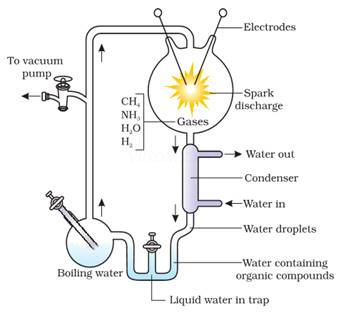
Ans.Urey & miller tried to create in the laboratorythe similar conditions which might have existedin early primitive atmosphere. A mixture of watervapours methane, ammonia & hydrogen is exposedto electric discharge in a closed chamber, this fluidthus formed is allowed to stand for several week as aresult, amino acids e.g. glycerine& alanine areformed from fluid. They suggested that electric discharge produced during lightening in primitiveatmosphere of earth might have resulted in formation of organic compound.
11.What is Biogenetic law? How does comparative embryology provides evidences for evolution?
Ans.It has become evident from embryological studies that there was one developmental pattern.
In all organisms life begins with a unicellular structure. The embryo of fish, frog, turtle, bird & manresembles one another so closely that it becomes difficult to distinguish them. Mammalian embryoparses through fish – like, amphibian-like, reptiles like & bird like stages during development of anorganism (ontogeny), some of the evolutionary steps (phylogeny) are repeated in different group oforganism. This leads Ernst Haeckal to formulate famous theory – “RECAPITULATION THEORY /
BIOGENETIC LAW.Which states that “Ontogeny recapitulates phylogeny” The sequence ofembryonic development shows striking similarity e.g. appearance of gill cleft and notochord inembryonic development of all vertebrates from fish to man.
12.Chemical insectides remain useful only for a limited time. Explain with reference to evolution with a suitable example.
Ans.“Chemical insectides remain useful only for a limited time” because of the phenomena ofnatural selection with the course of time when chemical insecticides are excessively used to killinsects, some of the resistant varieties of the organism would have been created which are notkilled lay the insect icicle such resistant varieties of the unseats are selected lay nature & theymultiply after sometime population of this resistant variety increases & the chemical insecticidewould lee ineffective to control these insects for example DDT is a common insecticide formosquitoes lout is now ineffective because DDT – resistant mosquitoes have appeared & selected innature.
13.What are the facts that support Darwin’s theory of Natural selection?
Ans.The following facts that supports Darwin’s theory of Natural selection
- Overproduction: – All organisms tend to multiply at high rate but it is not possible for allorganisms to survive.
- Struggle for Existence: – Because of limitation of space & food all the offspring of the result ofoverproduction will not survive & they will compete with one another to grow this develops struggle for existence not only among individuals of different species but also among same species.
- Variations :- No two individuals of same species are exactly alike even coming out from sameparent al stock.
- Survival of fittest :- The individuals with useful variation will survive during struggle of existencewhile those with less fortunate variation would perish.
14.Trace the important events or stages of human development?
Ans.The common ancestor of apes & man is a primate Dryopithecus that lived about 15 millionyears ago the human evolution is as follows :-
- Australopithecus :- They are 4ft, with brain capacity – 500 to 650 cc. They have bipedal locomotion, omnivorous &has erect posture. They hunted with stone weapon & lived in caves.
- Homo Erectus :- They showed increase in brain size They are good hunters, ate meat domesticate animal & discover fire.
- Netherlands man :- They were short with heavy brows retreating forehead large jaws & stooped postures They wore clothes, good hunters & tool makers.
- Cromagnonman :- They were completely erect & 6ft tall. He used bones as tools & was a cave dweller. They are excellent tool makers & fine artists.
- Homo sapiens :- They have brain capacity 1450cc. & skull much thicker. His intelligence has enabled him to adapt & control environment. He started agriculture.
15.What are the three different ways in which selection may occur.
Ans.The three different ways in which selection may occur are as below:-
(i) StablisingSelection :- Individuals with intermediate value of heritable phenotypic characteristics are favoured over other individuals.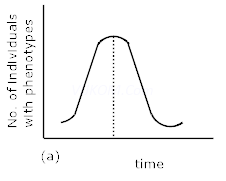
(ii) Directional Selection :- Individuals with one extreme of heritable phenotypic characteristic have an advantage over individuals in a population.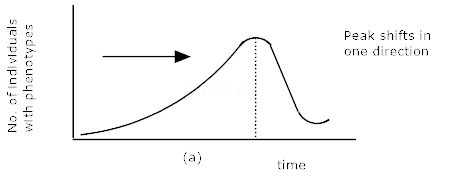
(iii) Disruptive Selection :- individuals with either of both extreme of heritable phenotypic characteristics have advantage over individuals with intermediate phenotype.
16.State in what ways Stanley miller simulated the condition of :-
i) Primitive atmosphere on earth.
ii) Energy source at the time of origin of life .
iii) Formation of organic molecule of life.
Ans. i) A fluid containing mixture of methane, ammonia, hydrogen & water vapour in a closed flask.
ii) Energy source during origin of life was sun. This energy in the experiment is provided lay electricdischarge using electrode.
iii) Organic molecules formed during experiment are amino acids.
17.What is Biogeography? How Darwin’s finches provide biogeographical evidence in favour of evolution.
Ans.The branch of geography which deals with the study of pattern of distribution of plants &animals in different parts of earth is called Biogeography.
Example Galapagos islands – group of 14 islands in Pacific Ocean on west coast of South America.Charles Darwin during his voyage found that animals of these is lands resembles with those of SouthAmerican is lands. E.g. birds of Galapagos Island called Darwin’s finches do not resemble birds ofSouth America so he concluded that finches were derived from ancestral stock that had emigratedfrom mainland to island & has undergone profound changes under environmental conditions.
18. How did louispasteur successfully demolish the popular theory of spontaneous generation?
Ans.Louis Pasteur used a special swam-necked flask for his experiment. He took mixture of sugar &yeast powder & filled about half of it with water in this flask. He then boiled the content of flask till asteady current of steam rushed out from s-shaped tube –causing death of all microorganisms. Afterthis flask remains unchanged. But when neck of flask was cut-off showed thick growth ofmicroorganisms this is presumed that are contains microorganisms which in first case could notreach the flask whereas in second case they comes in direct contact with solution.
5 Marks Questions
Chapter 7
Evolution
5 Marks Questions
1. What does Hardy weinberg’s principle states? What are the factors which affects Hardyweinberg’s equilibrium?
Ans.Acc. to Hardy Weinberg’s principle, allele frequency in a population are stable & is constantfrom generation to generation i.e. total gene pool remains constant. This is called Geneticequilibrium e.g. In a diploid organism, suppose ‘p’ represents frequency of allele ‘A’ & ‘q’ representsfrequency of allele ‘q’.then frequency of AA = p2
“ “ Aa =pq
“ “ aa = q2
total alleles in F1 Generation
AA + 2Aa + aa = 1
P2 + 2pq + q2 = 1
(p + q) 2 = 1
Factors affecting Hardy – Weinberg Equilibrium :-
(i)Gene flow :- when migration of a section of a population to another place occurs, gene frequency changes in original as well as in new population.
(ii)Genetic Drift :- If just by virtue of a chance or accident a particular allele frequency decrease or increase in a population.
(iii)Mutations:- which are sudden changes in the genotype which are carried over generation.
(iv)Genetic Recombination:- Sometimes changes in allele frequency is so different in new sample of population that they become a new species.
(v)Natural Selection:- process by which individual with particular heritable characteristics survive & reproduces at higher rate than other individuals favored by natural selection tend to be more common in next generation than in parent generation.
2. How do Darwin and Hugo de Vries after regarding Mechanism of Evolution?
Ans.Darwin : Darwinian variatious are gradual, small and directional Hugo deVries : put forth idea of mutations, mutations are sudden random and directional
3. With the help of suitable diagram, represent the operation of naturalselection on different traits.
Ans. Natural selection is one of the basic mechanisms of evolution, along with mutation, migration, and genetic drift.
Darwin’s grand idea of evolution by natural selection is relatively simple but often misunderstood. To find out how it works, imagine a population of beetles:
1. There is variation in traits.
For example, some beetles are green and some are brown.
2. There is differential reproduction.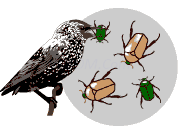
Since the environment can’t support unlimited population growth, not all individuals get to reproduce to their full potential. In this example, green beetles tend to get eaten by birds and survive to reproduce less often than brown beetles do.
3. There is heredity.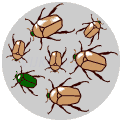
The surviving brown beetles have brown baby beetles because this trait has a genetic basis.
4. End result: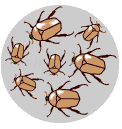
The more advantageous trait, brown coloration, which allows the beetle to have more offspring, becomes more common in the population. If this process continues, eventually, all individuals in the population will be brown.
If you have variation, differential reproduction, and heredity, you will have evolution by natural selection as an outcome. It is as simple as that.
4.What does Oparin – haldane hypothesis about origin of life suggests.
Ans.According to Oparin& Haldane’s Biochemical origin of life; origin of life occurs in three stages
5.What is Chemogeny?
Ans. CHEMOGENY / CHEMICAL EVOLUTION :-Acc to them most of the primitive form of life would have generated spontaneously from some inorganic matter as a result of action of special external forces e.g. electric charge, uv-light etc.
- Many saturated & unsaturated hydrocarbons were feasted when temp cooled to 900 c or below.
- From hydrocarbons small chain compounds of C, H, O are formed which condense to form sugar.
- Ketones & aldehydes condenses&polymerises to form fatty acid.
- Ammonia, hydrocarbon & H2 O reacted together to form amino acid.
- Hot sea water which was rich in primary organic compound reacted to form nucleotides.
6. What is biogeny?
Ans. BIOGENY / BIOLOGICAL EVOLUTION :- This stage consists of
i)Formation of nucleic acids by polymerization of nucleotide.
ii)Giant molecules of nucleoproteins have a tendency to be aggregated in various combinations to form large colloidal particles called COACERVATES.
iii)The development of plasma membrane resulted in accumulation of different substances inside coacervates& occurrence of certain internal reaction lad to development of cell.
7. Whai is Cognogeny?
Ans. Cognogeny :-Cognogeny involves differentiation or diversification of living beings from simplest first living cell. The first organism evolved was chemo- autotrophic bacteria which later converted to tree autotrophic bacteria e.g. green algae.
Evolution Class 12 Biology MCQs
1. Evolutionary convergence is characterised by
(а) development of characteristics by random mutations.
(b) development of similar characteristics in different groups of organisms of different ancestry.
(c) development of dissimilar characteristics in closely related groups of organisms.
(d) development of similar characteristics in related groups of organisms.
Answer
Answer: b
2. Homologous organs indicate
(a) convergent evolution.
(b) divergent evolution.
(c) adaptive radiation.
(d) natural selection.
Answer
Answer: b
3. Darwin judged the fitness of individuals by
(a) ability to defend itself.
(b) strategy to obtain food.
(c) number of offspring produced.
(d) dominance over other individuals.
Answer
Answer: c
4. Change of frequency of alleles in a population results in evolution. This statement is proposed in
(a) Darwin’s theory
(b) Lamarck’s theory
(c) Hardy-Weinberg principle
(d) de Vries theory.
Answer
Answer: c
5. Select the correct statement from the following options.
(a) Mutations are random and directional.
(b) Darwinian variations are small and direction less.
(c) Fitness is the end result of the ability to adapt and get selected by nature.
(d) All mammals have evolved vivipary as an adaptation.
Answer
Answer: c
6. Which type of selection is industrial melanism observed in moth, Biston bitularia [NCERT Exemplar]
(a) Stabilising
(b) Directional
(c) Disruptive
(d) Artificial
Answer
Answer: b
7. Analogous organs arise due to [NCERT Exemplar]
(a) divergent evolution
(b) artificial selection
(c) genetic drift
(d) convergent evolution
Answer
Answer: d
8. The bones of forelimbs of whale, bat, cheetah and man are similar in structure, because [NCERT Exemplar]
(a) one organism has given rise to another
(b) they share a common ancestor
(c) they perform the same function
(d) they have biochemical similarities.
Answer
Answer: b
9. Appearance of antibiotic-resistant bacteria is an example of [NCERT Exemplar]
(a) adaptive radiation
(b) transduction
(c) pre-existing variation in the population
(d) divergent evolution.
Answer
Answer: c
10. In 1953 S. L. Miller created primitive earth conditions in the laboratory and gave experimental evidence for origin of first form of life from preexisting non-living organic s molecules. The primitive earth conditions created include [NCERT Exemplar]
(a) low temperature, volcanic storms, atmosphere rich in oxygen
(b) low temperature, volcanic storms, reducing atmosphere
(c) high temperature, volcanic storms, non¬reducing atmosphere
(d) high temperature, volcanic storms, reducing atmosphere containing CH4, NH3 etc.
Answer
Answer: d
11, The most accepted line of descent in human evolution is [NCERT Exemplar]
(a) Australopithecus → Ramapithecus → Homo sapiens → Homo habilis
(b) Homo erectus → Homo habilis → Homo sapiens
(c) Ramapithecus → Homo habilis → Homo erectus → Homo sapiens
(d) Australopithecus → Ramapithecus → Homo erectus → Homo habilis → Homo sapiens.
Answer
Answer: c
12. A study of fossils in different sedimentary layers indicates the ______ period in which they existed.
Answer/Explanation
Answer:
Explaination: Geological.
13. ______evolution leads to homologous organs.
Answer/Explanation
Answer:
Explaination: Divergent.
14. Placental mammal lemur in Australia shows resemblance to the marsupial mammal, ______ .
Answer/Explanation
Answer:
Explaination: Spotted Cuscus.
15. Placental mammals and marsupial mammals of Australia show ______ evolution.
Answer/Explanation
Answer:
Explaination: Convergent.
16. De Vries believed that single step large mutation, called ______ caused speciation.
Answer/Explanation
Answer:
Explaination: Saltation.
17. ______ evolved into the first amphibians.
Answer/Explanation
Answer:
Explaination: Lobefins.
18. About 65 mya, ______ suddenly disappeared from the earth.
Answer/Explanation
Answer:
Explaination: Dinosaurs.
19. ______ probably lived in East African grasslands about 2 mya.
Answer/Explanation
Answer:
Explaination: Australopithecus.
20. The brain capacities of Homo habilis was about ______ cc.
Answer/Explanation
Answer:
Explaination: 650-800 cc
21. Fossils of ______ were discovered in Java.
Answer/Explanation
Answer:
Explaination: Homo erectus.
22. Match the items in Column I with those in Column II.
| Column I | Column II |
| A. Ice-age (75000 – 10000 years before) | 1. Neanderthal man. |
| B. 1.5 mya | 2. Agriculture started. |
| C. Brain size of 1400 cc | 3. Homo erectus; they probably ate meat. |
| D. 10000 years before | 4. Modern Homo sapiens arose. |
| 5. Homo habilis; they probably did not eat meat. |
Answer/Explanation
Answer:
Explaination: A – 4, B – 3, C – 1, D – 2
23. Match the organisms in Column I with the geological time scale of their appearance on the globe.
| Column I | Column II |
| A. lawless fish | 1. 500 mya |
| B. Dryopithecus | 2. 320 mya |
| C. Sea weeds | 3. 350 mya |
| D. Invertebrates | 4. 200 mya – dominated the earth |
| E. Reptiles | 5. 15 mya |
| 6. 1.5 mya |
Answer/Explanation
Answer:
Explaination: A – 3, B – 5, C – 2, D – 1, E – 4
24. Prehistoric cave art developed after agriculture, about 18000 years ago. [True/False]
Answer/Explanation
Answer:
Explaination: False.
25. The skull of baby chimpanzee is more like the adult human skull than the skull of adult chimpanzee. [True/False]
Answer/Explanation
Answer:
Explaination: True.
26. It is believed that 3-4 mya, man-like primates walked in Eastern Africa.[True/False]
Answer/Explanation
Answer:
Explaination: True.
27. Due to continental drift, pouched mammals of Australia survived due to lack of competition. [True/False]
Answer/Explanation
Answer:
Explaination: True.
28. Tyrannosaurus was the smallest among the dinosaurs. [True/False]
Answer/Explanation
Answer:
Explaination: False.
Directions (Q29 to Q32): Mark the odd one in each of the following groups.
29. Carboniferous, Triassic, Devonian, Permian.
Answer/Explanation
Answer:
Explaination: Triassic.
30. Bobcat, Wolf, Ant eater, Spotted cuscus.
Answer/Explanation
Answer:
Explaination: Spotted cuscus.
31. Human hands, Wings of butterfly, Wings of bat, Wings of birds.
Answer/Explanation
Answer:
Explaination: Wings of butterfly.
32. Lamarckism, Darwinism, Branching descent, Natural selection.
Answer/Explanation
Answer:
Explaination: Lamarckism.
33. What is Evolutionary Biology?
Answer/Explanation
Answer:
Explaination: Evolutionary Biology is the study of history of life forms on earth.
34. When was the earth supposed to have been formed and when did life appear on the earth?
Answer/Explanation
Answer:
Explaination:
– Earth was supposed to have been formed ’ 4.5 billion years before.
– Life appeared about four billion years ago.
35. What was the idea of early Greek thinkers about origin of life?
Or
What is Theory of Panspermia?
Answer/Explanation
Answer:
Explaination: According to this theory (of early Greek philosophers) it was believed that units called ‘Spores’ or ‘pansperms’ came on the earth along with meteorites and they must have evolved into the various life forms.
36. Name the scientist who disproved spontaneous generation theory. [Delhi 2010]
Answer/Explanation
Answer:
Explaination: Louis Pasteur disproved the spontaneous generation theory.
37. State the two principal outcomes of the experiments conducted by Louis Pasteur on origin of life. [Delhi 2019]
Or
What did Louis Pasteur’s experiment on ‘Killed yeast’ demonstrate? Name the theory that got disproved on the basis of his experiment. [Foreign 2013]
Answer/Explanation
Answer:
Explaination:
– It demonstrated that life comes only from pre-existing life.
– Theory of spontaneous generation was disproved.
38. What role does an individual organism play as per Darwin’s theory of natural selection? [Delhi 2017]
Answer/Explanation
Answer:
Explaination: The individual organism passes on the (genetic) variations) to the next generation; the useful variations are selected by nature and it can lead to speciation.
39. How did Charles Darwin express ‘fitness’? [Delhi 2019]
Or
What is ‘fitness’ of an individual according to Darwin? [Delhi 2017]
Answer/Explanation
Answer:
Explaination: The fitness, according to Darwin, refers ultimately to reproductive fitness.
40. Name the scientist who also came to similar conclusion as Darwin. Where did he work?
Answer/Explanation
Answer:
Explaination: Alfred Wallace. He worked in Malay Archepelago.
41. What are fossils?
Answer/Explanation
Answer:
Explaination: Fossils are the remnants and/or impressions of the life-forms that lived in the remote past.
42. Define biogeography.
Answer/Explanation
Answer:
Explaination: Biogeography refers to the study of distribution of living organisms in different parts of the earth.
43. Name any two vertebrate body parts that are homologous to human forelimbs.
Answer/Explanation
Answer:
Explaination: Wings of birds, flippers of whales, forelimbs of dog/cat, wings of bats. (any two)
44. Identify the examples of convergent evolution from the following: [Delhi 2013]
(a) Flippers of penguins and dolphins.
(b) Eyes of Octopus and mammals.
(c) Vertebrate brains.
Answer/Explanation
Answer:
Explaination: (a) and (b)
45. Identify the examples of homologous structures from the following: [Delhi 2013]
(a) Vertebrate hearts.
(b) Thoms in Bougainvillea and tendrils of Cucurbita.
(c) Food storage organs in sweet potato and potato.
Answer/Explanation
Answer:
Explaination: (a) and (b)
46. Name the type of evolution that has resultedin the development of structures like wings of butterfly and bird. What are such structures called? [Delhi 2014 C]
Answer/Explanation
Answer:
Explaination:
– Convergent evolution.
– They are called analogous organs/ structures.
47. ‘Sweet potato tubers and potato tubers are the result of convergent evolution’. Justify the statement. [Delhi 2013]
Answer/Explanation
Answer:
Explaination: Sweet potato tubers and potato tubers are analogous structures, evolved for the same function; analogous structures result from convergent evolution.
48. Write the similarity between the wing of a butterfly and the wing of a bat. What do you infer from the above with reference to evolution? [Delhi 2012; HOTS]
Or
Comment on the similarity between the wing of a cockroach and the wing of a bird. What do you infer from the above with reference to evolution? [AI 2012; HOTS]
Or
Comment on the similarity between the flippers of dolphins and penguins, with reference to evolution. [Foreign 2012]
Answer/Explanation
Answer:
Explaination:
– They are analogous organs, which perform similar functions, but are dissimilar in their anatomy and origin.
– Analogous organs are the result of convergent evolution.
49. State the significance of biochemical similarities amongst diverse organisms in evolution. [Delhi 2012]
Answer/Explanation
Answer:
Explaination: The biochemical similarities point to the same shared ancestry among diverse organisms.
50. State a reason for the increased population of dark-coloured moths coinciding with the loss of lichens (on tree barks) during industrialisation period in England. [Foreign 2015]
Answer/Explanation
Answer:
Explaination:
– During the post-industrialisation period, the tree trunks became dark due to deposition of industrial smoke and soot.
– The dark-coloured moths were able to camouflage better and were not picked up by the predators and hence, increased their population size.
51. Why are lichens regarded as pollution indicators?
Answer/Explanation
Answer:
Explaination: Since, they do not grow in areas that are polluted, lichens are regarded as pollution indicators.
52. Name two animals that have evolved along with Tasmanian wolf in the Australian continent.
Answer/Explanation
Answer:
Explaination: Sugar glider/Bandicoot/Koala/Numbat/ Wombat/Kangaroo/Marsupial rat/ Marsupial mole.
53. What is the basis of origin of variations in organisms as described by Hugo de Vries? [AI 2013C]
Answer/Explanation
Answer:
Explaination: Mutation.
54. List the two characteristics of mutation that help in explaining evolution. [Delhi 2011C]
Answer/Explanation
Answer:
Explaination:
Mutations are:
(i) random, and
(ii) directionless.
55. According to de-Vries, what is saltation? [Delhi 2016]
Or
What is saltation according to De-Vries? [Delhi 2014C]
Answer/Explanation
Answer:
Explaination: Saltation refers to single-step large mutation that results in speciation.
56. What does Hardy-Weinberg equation p² + 2pq + q² = 1, convey? [Foreign 2011]
Answer/Explanation
Answer:
Explaination: It indicates genetic equilibrium, i.e. the allele frequencies in a population are stable and remain constant from generation to generation.
57. What is evolution according to Hardy- Weinberg? [CBSE Sample Paper 2013, 2014]
Answer/Explanation
Answer:
Explaination: Disturbance in genetic equilibrium, i.e. change of frequency of alleles in a population, would be considered as evolutionary change.
58. How does a population become ‘founders’ of a new species? [AI 2012C]
Or
When does a species become founders to cause founder effect? [Foreign 2010]
Answer/Explanation
Answer:
Explaination: When the change in allele frequency is so different that the new sample of population becomes a different species, the original drifted population becomes founders to cause founder effect.
59. According to Hardy-Weinberg principle, the allele frequency of a population remains constant. How do you interpret the change of frequency of alleles in a population?
Answer/Explanation
Answer:
Explaination: The change in frequency of alleles indicates evolutionary change.
60. Pick out the ancestral line of Angiosperms from the list: Conifers, Seed ferns, Cycads, Ferns.
Answer/Explanation
Answer:
Explaination: Seed ferns.
61. Coelacanth was caught in South Africa. State the significance of discovery of Coelacanth in the evolutionary history of vertebrates. [Guwahati 2019]
Or
State the significance of Coelacanth in evolution. [AI 2012]
Answer/Explanation
Answer:
Explaination:
– Coelacanth has evolved into the first amphibians; they are fish with stout and strong fins that could move on land and go back to water.
– They were thought to be extinct.
62. What technical term is given to the fish-like reptiles?
Answer/Explanation
Answer:
Explaination: Ichthyosaurs.
63. Write the names of the following:
(a) A 15 mya primate that was ape-like.
(b) A 2 mya primate that lived in East African grasslands. [CBSE 2018]
Answer/Explanation
Answer:
Explaination:
(a) Dryopithecus
(b) Australopithecus
64. Name the common ancestor of great apes and man. [AI 2011]
Answer/Explanation
Answer:
Explaination: Dryopithecus
65.
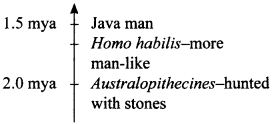
Study the ladder of human evolution given above and answer the following questions: [Delhi 2010C]
(a) Where did Australopithecines evolve?
(b) Write the scientific name of Java man.
Answer/Explanation
Answer:
Explaination:
(a) Australopithecines evolved in East African Grasslands.
(b) Homo erectus.
